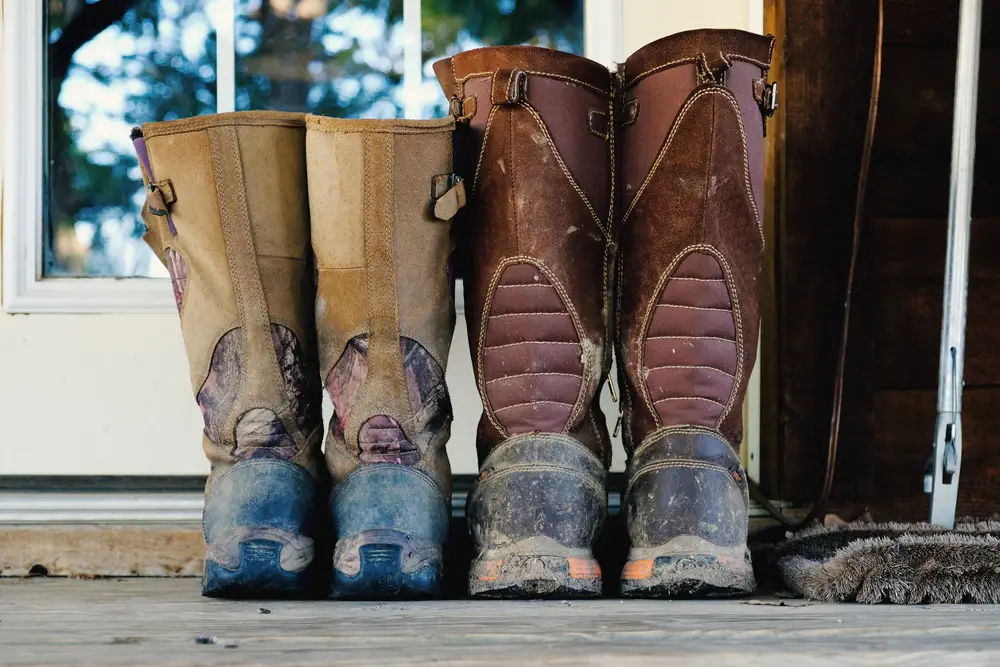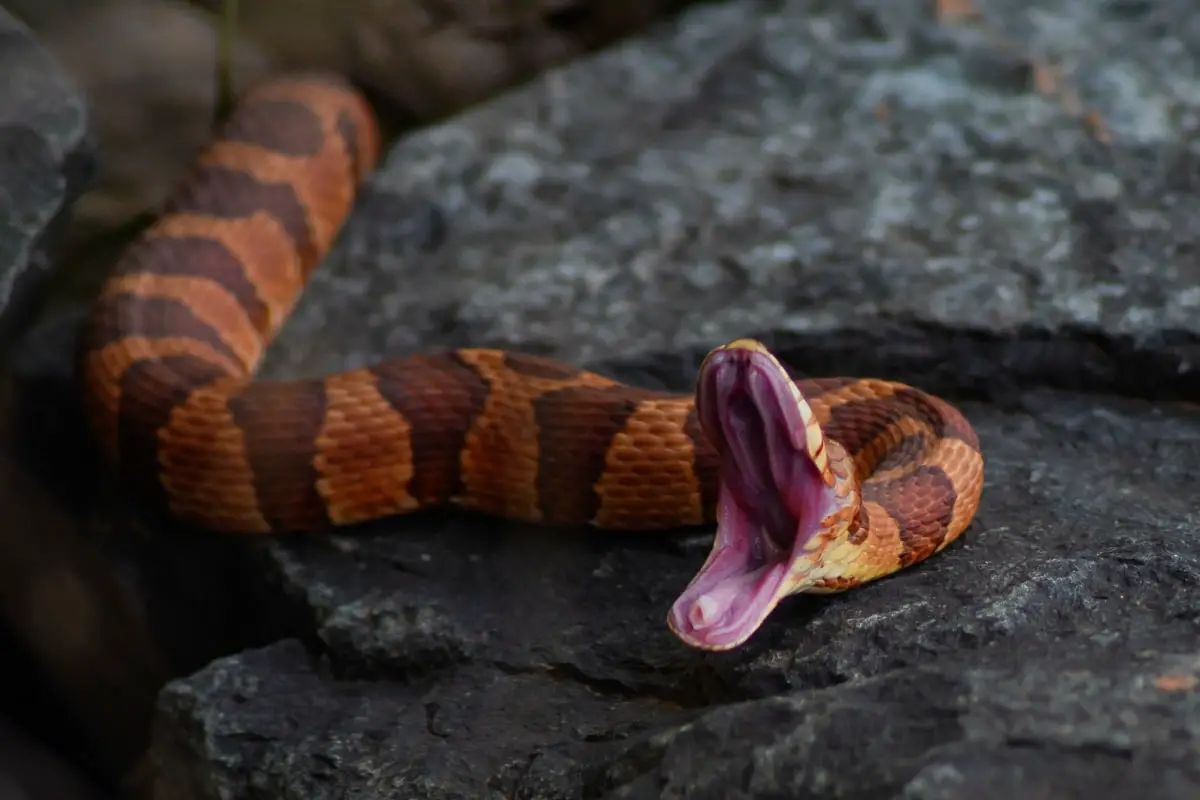Avoiding snake bites is not difficult. If you are prepared and follow these foolproof snake bite avoidance tips, then you should be safe in even the most snake-infested places.
Here are 9 foolproof tips to follow:
#1 Wear Snake Boots
If you must work or hunt where snakes live, then a pair of snake boots is a great investment.
Snake boots are specially designed to protect the entire feet and lower legs from snake bites. Their construction deflects snake fangs and prevents the fangs and any venom from reaching your skin.
Snake boots are specifically designed to cover the entire foot, upper and lower legs — the main places an unwary step can result in a dangerous snake bite. These boots are made of snake-proof fabrics so you don’t have to worry about getting bitten.

#2 Wear Snake Pants or Chaps
Snake pants and chaps are excellent additions along with snake boots for protecting your legs from the ankles to hips.
Snake-proof pants and chaps are made of snake-proof materials with a tough construction that prevents snake bites from penetrating the skin. They cover the entire area from the ankles to the upper legs.
Here are some highly-rated snake pants and chaps that provide great snake bite and thorn protection:
Chaps generally provide more dedicated snake protection than pants. This is because chaps are meant to wear over another pair of pants and do not have to flex as much as a pair of pants. They are generally made of tougher, thicker material. The downside of chaps is they aren’t as comfortable as pants and tend to weigh significantly more. So hiking long distances in chaps can be strenuous and sweaty in hot weather.
Snake pants and chaps are far more tear- and puncture-resistant than normal jeans, khakis, or cargo pants. This makes them great for walking through brush, briars, barbed wire and wet vegetation. They are really all-around combo garments that give your lower extremeties substantial protection from lacerations, bites and puncture wounds.
Snake pants and chaps typically offer enough bite protection for even professional snake handlers. They’re definitely a great addition to your outdoor gear that will help avoid dangerous snake bite injuries.
#3 Wear Snake Gaiters
Snake gaiters are extra protection for the ankle, top of the foot (metatarsal), and lower leg region from snake bites. Gaiters are a good choice if you don’t want to invest in dedicated snake boots and you already have a pair of heavy-duty snakeproof boots.
Snakes will have a hard time biting above the knees unless you pick them up (which you shouldn’t!). Snake gaiters give you full protection up to knee level, but no higher.
If you do not have snake boots or snake pants, wearing snake gaiters can enhance the protection of normal hiking boots and pants. This is generally less expensive than snake boots and pants as well.
#4 Stay On Trails
Snakes like to stay hidden in grasses, under rocks and logs, and generally avoid attracting attention to themselves. They are more likely to avoid open areas such as hiking trails unless they are trying to get to the other side. While you can come across the occasional snake relaxing on a pathway, they will slither away quickly when a threat comes along.
An easy way to avoid snakes is to not chase or follow them off the path or walk through their territory where they are trying to stay hidden. Also, follow any trail direction or warning signs about potential dangers in the area. If you do this, you will minimize the risk of getting bitten by snakes while hiking.
#5 Know Your Snake Territory

Depending where you’re walking — be it grassland, rocky terrain, swamp or forest — it pays to know where snakes typically are on the ground.
Grasslands and prairies are prime snake territories, especially in drier climates. There are streams, rocks, boulders, and tree debris which snakes like to rest near. Grasslands and prairies are also filled with small prey snakes can eat. So, to avoid snakes stay away from tall grasses that have no pathway through and stick to the trail.
#6 Be Aware In Hot and Dry Climates
Snakes are cold-blooded animals and need warm weather to keep their body temperature high enough for movement. If the temperature drops too low, snakes will hibernate. So, snakes are more common in hot and dry climates such as in Australia, the southwest USA, and Africa. If you want to avoid snakes, try visiting a colder northern region.
#7 Be Alert Around Wooden Decks
Snakes like to hide under wooden decks to keep cool and stay safe. So, if you live in a warm climate and have an attached deck to your house, a snake could be living underneath. Also, wood decks attached to work trailers, school buildings, and restaurant outdoor areas could have snakes hiding beneath them. Avoiding the underside of wooden decks is a great way to void snakes.
#8 Wear Great Western Boots
A special pair of cowboy boots is designed tough enough to resist snake bites. These are called great western boots and are popular amongst farmers due to their strength and durability. They are more snake resistant than normal cowboy boots. If you want to stay protected from snakes, get a pair of great western boots before goin into snake territory.
#9 More Tips If You Must Traverse Snake Territory…
Completely avoiding areas with snakes may not be practical in some circumstances.
If you must traverse snake territory, here are some simple guidelines to keep safe:
- Walk slowly and carefully through the brush
- Be aware of the snake species in the area
- Wear thick socks underneath your hiking or snake boots (this creates additional distance between the hard boot and your soft skin that snake fangs must penetrate)
- Do not approach a snake if you find one
- Watch the path in front of you for any snakes lying in the sun
- Beware of snakes near rocks and boulders
- Do not toy with snakes with sticks or try to pick them up
- Avoid even non-venomous snakes (mostly) such as constrictors, rat snakes, king snakes, gopher snakes and garden snakes. They may still bite and give you an infection.
Important! Kids and Snake Bites
Keep an eye on your kids and teach them to avoid snakes. Kids like to explore and touch small creatures, but snakes can cause them serious harm. A rattlesnake or water moccasin bite can make an adult sick, but may disable or even kill a small child.
You can buy snake pants and boots that fit kids or alter a pair with folded legs and a tightened belt. A simple way could be to just keep your kids close or avoid snake territory completely when planning a family hiking or camping trip.
Snakes Are Just Trying To Survive
Remember, snakes are just trying to survive like other animals and will strike a human if they feel threatened. Snakes are can be attractive to look at and interesting to be near, but they are dangerous and can cause serious injury. Avoiding snake bites can be as simple as using common sense and not approaching a snake when you find one.

